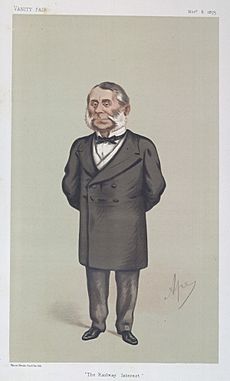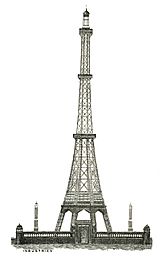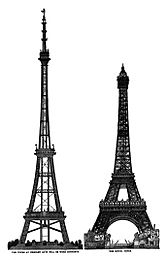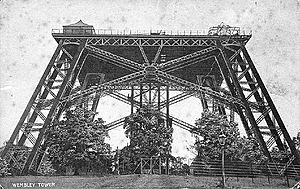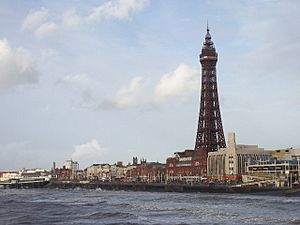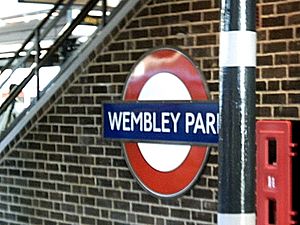Watkin's Tower facts for kids
Quick facts for kids Watkin's Tower |
|
|---|---|
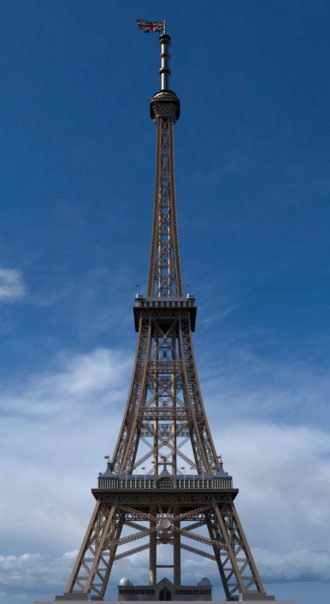
Artist's impression of Watkin's Tower
|
|
| General information | |
| Status | Never completed |
| Type | Observation tower |
| Location | Wembley Park, London, England |
| Coordinates | 51°33′20″N 0°16′46″W / 51.55556°N 0.27944°W |
| Construction started | 1891 |
| Completed | 1894 |
| Opening | May 1896 |
| Demolished | 1907 |
| Height | |
| Antenna spire | Original: 358 m (1,175 ft) Finally: ~47 m (154 ft) |
| Design and construction | |
| Architect | Sir Benjamin Baker |
| Developer | Stewart, MacLaren and Dunn |
| Main contractor | Metropolitan Tower Construction Company |
The Watkin's Tower was a huge metal tower planned for Wembley Park, London, England. It was meant to be a super tall observation tower and a fun place for visitors. The idea came from a railway boss named Sir Edward Watkin. He wanted to build a tower even taller than the famous Eiffel Tower in Paris!
The tower was called the "Great Tower of London". It was part of a big plan to make Wembley Park a popular spot for people to visit. Sadly, the tower was never finished. It was taken down in 1907. Today, the famous Wembley Stadium, where the English national football team plays, stands where the tower was supposed to be.
Contents
What Was Watkin's Tower Called?
The tower had many names and nicknames. People called it Watkin's Tower, Watkin's Folly (meaning a silly idea), the Wembley Park Tower, the Wembley Tower, the Metropolitan Tower, and even the London Stump.
The Story of Watkin's Tower
Sir Edward Watkin (1819–1901) was a very important person in Britain. He was a Member of Parliament and a railway boss. He led many different railway companies. Sir Edward was a big thinker with many grand ideas. He wanted to build a tunnel under the English Channel to connect his railways to France. He also built the Great Central Main Line railway.
Sir Edward was also in charge of the Metropolitan Railway in London. This company later became part of the London Underground. He wanted more people to ride his trains. So, he bought land near a small village called Wembley. His plan was to build a huge amusement park there.
The park would have lakes for boating, a waterfall, beautiful gardens, and sports fields. The main attraction would be the tall metal tower. It would offer amazing views of the countryside. It was also only a 12-minute train ride from Baker Street station in London.
People would get to Wembley Park by train. The Metropolitan Railway built a special station, Wembley Park station, just for the park. It opened in 1893–1894. Sir Edward thought many people would come to visit.
How the Tower Was Designed
The Eiffel Tower in Paris, France, inspired Sir Edward. He even asked Gustave Eiffel, who designed the Eiffel Tower, to design his tower. But Eiffel said no. He felt it would make French people think he wasn't a good Frenchman.
So, in 1890, a design contest was held. Sixty-eight different designs were sent in. Some ideas were very unusual! One idea was a tower like the Leaning Tower of Pisa. Another had a special parachute ride. One design even had a small version of the Great Pyramid of Giza. It was imagined as a place for "aerial vegetarians" to grow food in hanging gardens!
The winning design was from a company called Stewart, MacLaren and Dunn. Their plan was for a metal tower with eight legs. It would be 366 meters (1,200 feet) tall. This was taller than the Eiffel Tower, which was 312 meters (1,024 feet) at the time. The tower was supposed to have two viewing decks with restaurants, theaters, and dance halls. It would also have winter gardens, Turkish baths, and a 90-room hotel. At the very top, there would be a fresh-air health center and a place to look at the stars. The whole tower would light up with electric lights.
Sir Edward started a company to build the tower. He hired Benjamin Baker, a famous engineer. Baker had helped design the Forth Bridge. But the company couldn't raise enough money from the public. So, Sir Edward had to make the design cheaper. The eight-legged tower was changed to a four-legged one. It looked much more like the Eiffel Tower.
Building started in June 1893. At the same time, the park around it was being made ready. It included a cricket pitch and a boating lake.
Opening and Demolition
Wembley Park officially opened in May 1894. The tower was still being built. But the park was popular, attracting 12,000 visitors in 1895. In September 1895, the first part of the tower was finished. It stood about 47 meters (154 feet) tall.
Around this time, Sir Edward Watkin became ill and retired. Soon, problems were found with the tower's base. Making the tower cheaper by using fewer legs meant more weight on each leg. This caused the ground to sink.
Over the next few years, the company building the tower ran out of money. Work stopped in 1899. The tower was never completed. Sir Edward died in 1901. The unfinished tower was unsafe and closed to the public in 1902. Between 1904 and 1907, the part of the tower that had been built was taken down using dynamite.
Even though the tower failed, Wembley Park stayed a popular place. People came for football, cricket, cycling, and boating. In winter, they could ice skate on the frozen lake. After World War I, over a hundred sports clubs used the Wembley facilities. The company that built the tower changed its name to Wembley Park Estate Company in 1906. They started building houses and a golf course in the area.
After the war, Wembley was chosen for a big event called the 1924 British Empire Exhibition. The land was bought from the railway company. A huge sports arena, the British Empire Exhibition Stadium, was built for the event. This stadium, later known as Wembley Stadium, was built right where Watkin's Tower was. It opened in 1923 and became the home of the England national football team. When the stadium was rebuilt from 2000 to 2003, the old foundations of Watkin's Tower were found underneath.
What Happened After?
Watkin's "folly" wasn't the last attempt to build a famous tower in Britain. Other towers were built in the north of England, like the Blackpool Tower (1894), New Brighton Tower (1896), and Morecambe Tower (1898). Only the Blackpool Tower is still standing today.
Even though Watkin's Tower is gone, Wembley Park is still a very popular place. Many people come for sports games and music concerts at Wembley Stadium. The park was even used for the 1948 and 2012 Summer Olympics. The station built by the Metropolitan Railway is still used today. It helps people get to Wembley using the London Underground's Metropolitan and Jubilee lines.
There's even an Irish pub and restaurant in the area called Watkin's Folly.
The story of Watkin's Tower was told in a 1973 TV show called Metro-land. In the show, the poet Sir John Betjeman talked about Sir Edward's big dream:
Beyond Neasden there was an unimportant hamlet where for years the Metropolitan didn't stop. Wembley. Slushy fields and grass farms. Then out of the mist arose Sir Edward Watkin's dream: an Eiffel Tower for London.
—Sir John Betjeman, Metro-Land
The show also displayed some of the unusual designs that were not chosen for the tower. You can read the script for Metro-land in a book called Betjeman's England.
The Brent Museum also shares the history of Watkin's Tower. It's located in Willesden Green Library.
See also
 In Spanish: Torre de Watkin para niños
In Spanish: Torre de Watkin para niños


